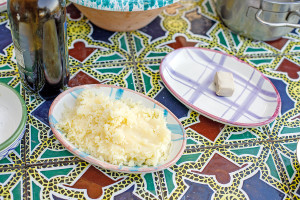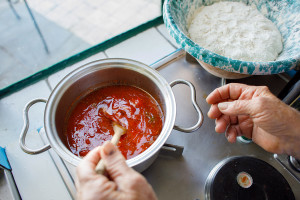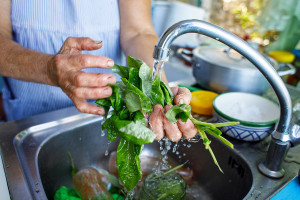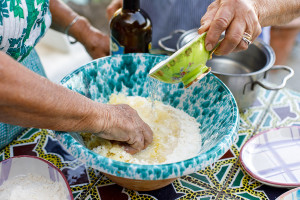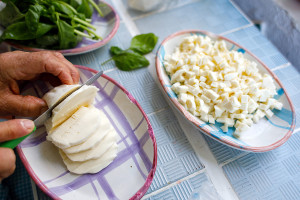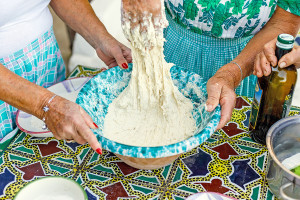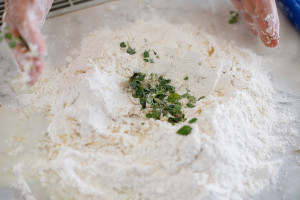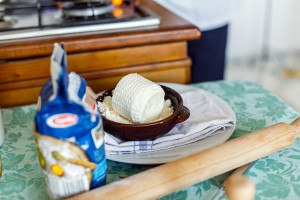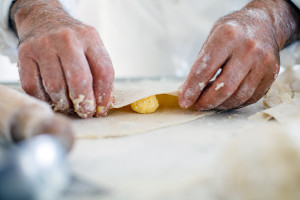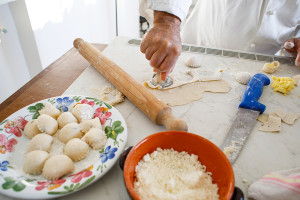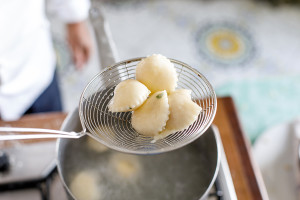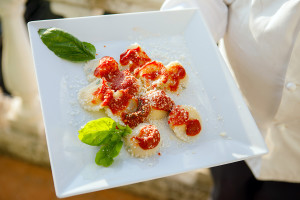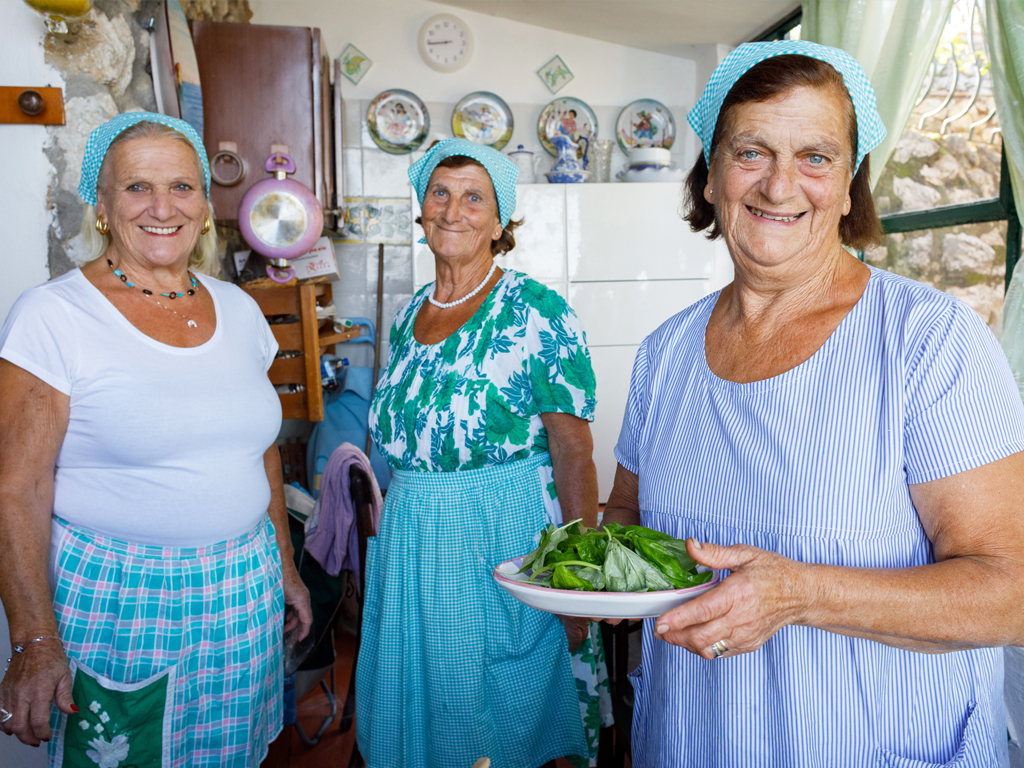
L’isola del gusto
I più capresi dei sapori raccontati da chi ne conosce tutti i segreti: le Pacchiane e Renato De Gregorio. Per loro cucinare è una vera passione
di Antonella Maresca | foto di Davide Esposito
«Lascia la pentola a minimo minimo che la salsa deve pippiare, vado a raccogliere il basilico» dice Rosa a Lena che taglia la mozzarella a dadini piccoli «perché accussì so più buoni» mentre Annamaria, la terza sorella, si occupa di friggere le loro famose montanare. Fu la signora Gaito, una signora di Napoli con la passione per la cucina che villeggiava ogni anno sull’isola, ad insegnare loro quando erano giovani ragazze questa prelibatezza che, oggi, le Pacchiane preparano a tutti i matrimoni dell’isola.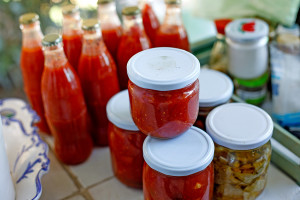
Una ricetta di successo che sarebbe niente però senza l’esperienza e la tecnica, l’energia nello sbattere l’impasto e l’abilità nel formare le pizzette con le mani rugose unte di olio. Nespole nataline, mele cotogne e sovere pelose (corbezzolo). Il loro orto è pieno di frutti dimenticati con cui si ottengono i più famosi liquori capresi, dal mirto al nocillo fino al più celebre limonillo, un’oasi di capritudine antica dove loro stesse sanno ancora sorprendersi: «sient che addore sta sarz – e cumm è bell cucinà davanti al mare». Il pomodoro, giunto con Ferdinando IV di Borbone, trova sull’isola diverse interpretazioni, pasta alla cchiummenzana con l’aggiunta della arecheta caprese (origano), sciuè sciuè, una versione semplificata con il burro dei maccheroni lardiati, e aumm aumm con le melanzane. Il pomodoro regna sovrano nel piatto caprese per eccellenza: i ravioli.
Comparsi per la prima volta nel 1922 nel menù di un convegno per la tutela del paesaggio organizzato da Edwin Cerio, come ravioli caprioti, restano immutati nel tempo, pasta senza uovo e ripieno di caciotta e maggiorana. «Nacquero nella zona di Marucella, dove si producevano le caciotte. Si facevano essiccare su alcune cannucce perché devono essere molto asciutte» racconta Renato De Gregorio, conosciuto da tutti come Renatino, mentre stende la pasta sottile come un velo. «Tutto avviene attraverso l’esperienza» dice mentre con gesti abili chiude a dovere i ravioli. «Avevo dodici anni e volevo fare il meccanico quando mia madre mi fece salire sulle cassette di bibite per arrivare meglio al bancone e mi mise a fare i ravioli». La sua storia con la cucina inizia così, al ristorante la Pigna, storico ritrovo per giocatori di bocce, per proseguire, come tutti gli isolani, oltre il mare. Alla Capannina di Forte dei Marmi, in Francia per la pasticceria, al Gino’s Restaurant di New York fino a Palm Beach con il maitre Renato Savorelli perché «prima di inventare piatti devi girare il mondo e vedere cosa dice». Besciamelle, filetto alla Chateaubriand, spaghetto con le vongole e torta caprese si alternano nei suoi racconti calorosi caratterizzati dalla voce roca dell’esperienza. «Bisogna aggiornarsi nel passato» dice mentre racconta del carrello dei dolci – usanza dimenticata – e delle origini della torta caprese, inizialmente chiamata torta Mussolini ma conosciuta dagli isolani come torta di mandorle, diffusasi nella baia di Marina Piccola ma di origini russe. La sua bontà soppianta di gran lunga una torta isolana più antica, quella di nocciole, oggi scomparsa. Nella sua casa vista mare, con il figlio Luigi, tiene dei corsi di cucina per stranieri per mostrare, ma non troppo, quanto «la cucina isolana, come la vita, è fatta di segreti».
Un’isola approdo e rifugio di necessità, tradizione e bellezza che crea sapori persi, ritrovati, reinventati, puramente isolani che quando ci si allontana non sono più gli stessi.
Di mare e di terra
Mirto, lauro, ruta, borragine, origano, finocchietto e basilico. Asparagi, funghi, limoni, carrube e fichi d’india. Ginepro, pino e rosmarino. La natura selvatica dell’isola di Capri può lasciare esterrefatti proprio come il suo mare. Passeggiando tra gli odori di quest’isola si scopre una tradizione antica, un genius loci gastronomico che trova le sue radici nei vizi degli imperatori romani, nella cultura greca, nell’operosità certosina, nelle influenze della vicina terraferma. Una cucina meticcia, così come definita da Claretta Cerio, quella isolana, che si arricchisce di tutto ciò che porta il mare. Ai Greci si deve la coltura dell’ulivo e della vite che, ancora oggi, regalano produzioni capresi. Alle tavole degli imperatori la raffinatezza romana incontra il territorio nei pasti frugali di Augusto fatti di piccoli pesci soffritti, ostriche e ricci locali, e nei banchetti di Tiberio innaffiati da molto vino tra polpette di calamari e seppie profumate con garum. La terra arida e rocciosa prometteva solo una certa qualità di grano, aglio, fave e la dimenticata cicerchia da cui si ricavavano squisite zuppe.
Nella cucina tipica il mare non poteva esimersi: ricci, datteri e patelle si raccoglievano a nuoto mentre di notte con la lampara si pescavano i totani, base di un classico caprese, totani e patate. Sotto il dominio amalfitano, trovano origine le padellate di uccelletti, create con gli uccelli di passo, in particolare con la caccia delle quaglie, in quella località che tra gli anziani è ancora miez e’ parate, oggi corrispondente ai Due Golfi, dal nome delle reti utilizzate. Coltivazione di erbe mediche e produzione di caciottelle erano caratteristica dei monaci certosini esperti anche nella salagione per la conservazione del pescato, come quella delle alici, dando origine alla padellata del convento, scarole lessate ed impreziosite da colatura di alici. Nella tradizione contadina, uno dei piatti poveri per eccellenza erano gli scagliuozzi, polenta fritta realizzata con farina di miglio per questo chiamata anche migliacci. Non mancava la minestra maritata, nella versione caprese realizzata anche con le verracce (borragine), un’erba spontanea da cui si ricavavano anche delle zeppoline fritte, oggi del tutto scomparse, tranne nella memoria di quelle amabili signore caratterizzate da sorrisi e spasoni in testa ricolmi di bontà, le Pacchiane capresi. | Of land and sea. Myrtle, bay, rue, borage, oregano, fennel and basil. Asparagus, mushrooms, lemons, carob and prickly pear. Juniper, pine and rosemary. The world of nature on the island of Capri can leave you amazed, just like its sea. As you stroll around among the scents of the island, you discover an ancient tradition, a gastronomic genius loci that has its roots in the vices of the Roman emperors, in the ancient Greek culture, in the industriousness of the Carthusian monks, and in the influence of the nearby mainland.
The Capri cuisine is a mongrel cuisine, as Claretta Cerio called it, that enriches itself with everything that the sea has to offer. It owes the olive and vine cultivation, still in active production today, to the Greeks. On the tables of the Roman emperors, Roman refinement encountered locally grown produce in the frugal meals that Augustus used to eat, with small fried fish, local oysters and sea urchins, and in Tiberius’s banquets where wine flowed freely, with squid and cuttlefish croquettes flavoured with garum (a fermented fish sauce). The dry, stony ground could only offer a certain quality of wheat, garlic, fava beans and the now forgotten chickling pea which was used to make delicious soups.
Seafood was an indispensable element in the traditional cuisine: sea urchins, date shells and patella were collected by swimmers, while squid fishing took place at night and provided the basis for the classic Capri dish of squid and potatoes. Another dish consisting of pan-fried small birds dates from the period of Amalfi rule: it was made using birds caught during their migration, and particularly from quail-hunting, in the area that is still known among the old people as miez e’ parate, after the type of nets used to catch the birds, which is nowadays the area known as the Two Gulfs. The Carthusian monks used to cultivate medicinal herbs and make caciottelle (soft white cheeses), and were also experts in salting fish for preservation, such as anchovies, which gave rise to the typical monastery panfried dish of braised endives flavoured with a sauce of anchovy extract. In the peasant tradition, one of the most classic of simple dishes was scagliuozzi, fried polenta made with flour of millet (miglio), hence its other name: migliacci. Then there was the minestra maritata (a soup made from a mixture of meat and vegetables), which in the Capri version also contained verracce (borage), a native herb which was also used to make fried zeppoline (croquettes); these have now all but disappeared, although they linger on in the memory of those friendly, smiling women with baskets on their heads brimming with good things: the Capri Pacchiane.
Una cucina meticcia, così come definita da Claretta Cerio, quella isolana, che si arricchisce di tutto ciò che porta il mare. Ai Greci si deve la coltura dell’ulivo e della vite che, ancora oggi, regalano produzioni capresi. Alle tavole degli imperatori la raffinatezza romana incontra il territorio nei pasti frugali di Augusto fatti di piccoli pesci soffritti, ostriche e ricci locali, e nei banchetti di Tiberio innaffiati da molto vino tra polpette di calamari e seppie profumate con garum. La terra arida e rocciosa prometteva solo una certa qualità di grano, aglio, fave e la dimenticata cicerchia da cui si ricavavano squisite zuppe.
Nella cucina tipica il mare non poteva esimersi: ricci, datteri e patelle si raccoglievano a nuoto mentre di notte con la lampara si pescavano i totani, base di un classico caprese, totani e patate. Sotto il dominio amalfitano, trovano origine le padellate di uccelletti, create con gli uccelli di passo, in particolare con la caccia delle quaglie, in quella località che tra gli anziani è ancora miez e’ parate, oggi corrispondente ai Due Golfi, dal nome delle reti utilizzate. Coltivazione di erbe mediche e produzione di caciottelle erano caratteristica dei monaci certosini esperti anche nella salagione per la conservazione del pescato, come quella delle alici, dando origine alla padellata del convento, scarole lessate ed impreziosite da colatura di alici. Nella tradizione contadina, uno dei piatti poveri per eccellenza erano gli scagliuozzi, polenta fritta realizzata con farina di miglio per questo chiamata anche migliacci. Non mancava la minestra maritata, nella versione caprese realizzata anche con le verracce (borragine), un’erba spontanea da cui si ricavavano anche delle zeppoline fritte, oggi del tutto scomparse, tranne nella memoria di quelle amabili signore caratterizzate da sorrisi e spasoni in testa ricolmi di bontà, le Pacchiane capresi. | Of land and sea. Myrtle, bay, rue, borage, oregano, fennel and basil. Asparagus, mushrooms, lemons, carob and prickly pear. Juniper, pine and rosemary. The world of nature on the island of Capri can leave you amazed, just like its sea. As you stroll around among the scents of the island, you discover an ancient tradition, a gastronomic genius loci that has its roots in the vices of the Roman emperors, in the ancient Greek culture, in the industriousness of the Carthusian monks, and in the influence of the nearby mainland.
The Capri cuisine is a mongrel cuisine, as Claretta Cerio called it, that enriches itself with everything that the sea has to offer. It owes the olive and vine cultivation, still in active production today, to the Greeks. On the tables of the Roman emperors, Roman refinement encountered locally grown produce in the frugal meals that Augustus used to eat, with small fried fish, local oysters and sea urchins, and in Tiberius’s banquets where wine flowed freely, with squid and cuttlefish croquettes flavoured with garum (a fermented fish sauce). The dry, stony ground could only offer a certain quality of wheat, garlic, fava beans and the now forgotten chickling pea which was used to make delicious soups.
Seafood was an indispensable element in the traditional cuisine: sea urchins, date shells and patella were collected by swimmers, while squid fishing took place at night and provided the basis for the classic Capri dish of squid and potatoes. Another dish consisting of pan-fried small birds dates from the period of Amalfi rule: it was made using birds caught during their migration, and particularly from quail-hunting, in the area that is still known among the old people as miez e’ parate, after the type of nets used to catch the birds, which is nowadays the area known as the Two Gulfs. The Carthusian monks used to cultivate medicinal herbs and make caciottelle (soft white cheeses), and were also experts in salting fish for preservation, such as anchovies, which gave rise to the typical monastery panfried dish of braised endives flavoured with a sauce of anchovy extract. In the peasant tradition, one of the most classic of simple dishes was scagliuozzi, fried polenta made with flour of millet (miglio), hence its other name: migliacci. Then there was the minestra maritata (a soup made from a mixture of meat and vegetables), which in the Capri version also contained verracce (borage), a native herb which was also used to make fried zeppoline (croquettes); these have now all but disappeared, although they linger on in the memory of those friendly, smiling women with baskets on their heads brimming with good things: the Capri Pacchiane.
The island of taste
he most typical Capri flavours described by those who know all the secrets: the ‘Pacchiane’ and Renato De Gregorio. For them, cooking is a real passion
by Antonella Maresca | photos by Davide Esposito
“Leave the pot on the lowest heat possible so the sauce can pippiare (simmer gently), while I go and pick the basil,” says Rosa to Lena, who’s cutting the mozzarella into small cubes “because they’re tastier like that”, while Annamaria, the third sister, is busy frying their famous “montanare” (fried pizza). It was Signora Gaito, a Neapolitan lady with a passion for cooking, who used to spend her holidays on Capri every year, who taught them to make this delicacy as young girls, and now the ‘Pacchiane’ (a group of women who keep traditional Capri food and peasant customs alive) make it for all the weddings on the island. It’s a winning recipe, but it would be no good at all without the experience and technique, the energy devoted to kneading and knocking back the dough, and the skill in shaping the mini pizzas with rough hands, greased with olive oil. Christmas medlars, quinces and arbutus fruit: their garden is full of forgotten fruits which are used to make the most famous Capri liquors, from mirto (made with myrtle) to nocillo (with walnuts) and the more famous limonillo (with lemons): an oasis of ancient Capri traditions where they still even manage to surprise themselves: “Smell the wonderful aroma of this sauce – and it’s so lovely cooking beside the sea.” The tomato, which arrived with Ferdinand IV of the House of Bourbon, has found a range of different interpretations on the island: pasta alla cchiummenzana (tomatoes and fresh herbs) with the addition of Capri arecheta (oregano), sciuè sciuè (literally ‘Hurry, hurry!’), a simplified version of the traditional macaroni pasta with bacon lard, but using butter instead, and aumm aumm, pasta with aubergines. Tomatoes reign supreme in the traditional Capri dish par excellence: ravioli. The dish appeared for the first time in 1922, on the menu at a conference for preserving the landscape, organized by Edwin Cerio, listed as ravioli caprioti, and it has remained unchanged over time: pasta without egg, stuffed with caciotta cheese and marjoram. “It began in the Marucella district, where they used to make the caciotta cheese.
They would dry it on straw because it has to be very dry,” says Renato De Gregorio, known to everyone as Renatino, as he rolls out the pasta sheet, as thin as a veil. “Everything comes from experience,” he says as he seals the ravioli perfectly in one skilful movement. “I was twelve and wanted to become a car mechanic, when my mum made me stand on crates of drinks so I could reach the work top and got me making ravioli.” That is how his chef story started, at La Pigna restaurant, a traditional haunt of bocce players; and, as with all islanders, it continued across the sea. At the Capannina in Forte dei Marmi, in France for the pastry-making, at Gino’s Restaurant in New York and over to Palm Beach with the maitre d’, Renato Savorelli, because “before you can invent dishes you need to go around the world and see what people say.” Béchamel sauce, Chateaubriand steak, spaghetti with clams and Capri cake all feature in the lively stories he tells, in a voice grown husky through recounting his experiences. “You need to catch up with the past,” he says as he talks about the dessert trolley – a forgotten custom – and the origins of Capri cake, initially called Torta Mussolini but known to all the islanders as torta di mandorle (almond cake), which became widespread in the Marina Piccola area but is of Russian origin. This delicious cake has long superseded an older form of Capri cake made with hazelnuts, that has now disappeared. In his house with a sea view, together with his son Luigi, he gives cooking courses for foreigners to show, though without revealing too much, how “island cuisine, like island life, is made up of secrets.” An island berth and refuge of necessity, tradition and beauty, creating flavours, lost, rediscovered and reinvented: pure Capri flavours that, when you take them away from the island, are no longer the same.


